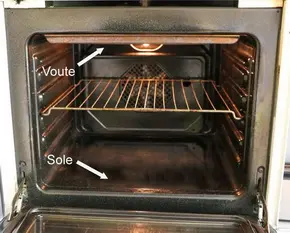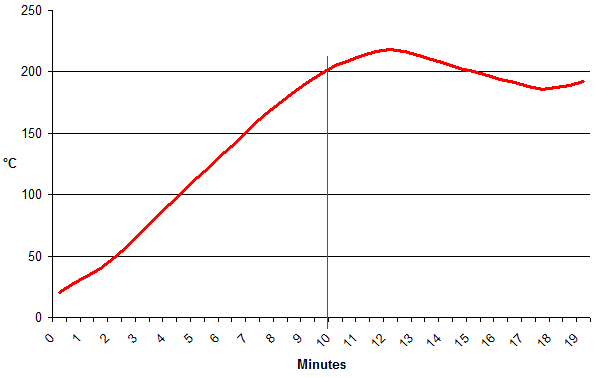This site uses only a few technical cookies necessary for its operation. By continuing to browse, you accept their use.
To find out more...
To find out more...
Should I believe my oven?

Can you really trust your oven? This is an important question as we are always tempted to take the temperature indicated as gospel truth and, unfortunately, this is rarely very precise.
33 K 4.6/5 (20 reviews)
Keywords for this post:OvenCookingTemperatureCheckingLast modified on: July 4th 2011
Should I believe my oven?
When I set my oven to 200°C, is it really at that temperature? The actual temperature can be measured easily if you have an accurate thermometer.
To check my own oven (a “De Dietrich” model UMP501), I placed the probe of the thermometer in the oven, closed the door, set it to 200°C and noted the temperature at 30 second intervals over 20 minutes.
Ideally, of course, the oven should heat up rapidly to exactly 200°C, then stay at this temperature until I open the door to put the food in, or until I turn it off. Unfortunately, the reality is dramatically different. Here is the temperature curve recorded:
From this graph we can note that:
1) The oven takes 10 minutes to reach 200°. So far, so good.
2) It beeps to tell me that it has reached 200° when, in fact, it is only at 191°, which is not so good.
3) Although it is supposed to stop heating at 200°C, it goes up to 217° before coming back down to 186°, and from then on it varies 10 or 20° around the set temperature, which is far from ideal.
These variations are significant but, fortunately, not the end of the world for most recipes. A little hotter or cooler doesn't make that much difference, and can be compensated by a slightly shorter or longer cooking time.
But take care, even so, with recipes that require a precise temperature, such as macarons or foie gras. For these, it is a good idea to measure the oven temperature when it indicates that it is at the right temperature, then adapt the recipe accordingly.
This is somewhat disappointing, as my oven was quite expensive at the time, and the salesman promised me an oven that had “precise temperature control” . But then, when it comes to selling, they always promise the moon.
So, in the end, in answer to the question “Should I trust my oven?” the reply is definitely: no, you should not trust your oven. Instead, you should measure and calibrate it beforehand to know how it really performs.
And then, we're talking here about an electric oven. Just imagine what's involved with a gas oven…
To check my own oven (a “De Dietrich” model UMP501), I placed the probe of the thermometer in the oven, closed the door, set it to 200°C and noted the temperature at 30 second intervals over 20 minutes.
Ideally, of course, the oven should heat up rapidly to exactly 200°C, then stay at this temperature until I open the door to put the food in, or until I turn it off. Unfortunately, the reality is dramatically different. Here is the temperature curve recorded:

From this graph we can note that:
1) The oven takes 10 minutes to reach 200°. So far, so good.
2) It beeps to tell me that it has reached 200° when, in fact, it is only at 191°, which is not so good.
3) Although it is supposed to stop heating at 200°C, it goes up to 217° before coming back down to 186°, and from then on it varies 10 or 20° around the set temperature, which is far from ideal.
These variations are significant but, fortunately, not the end of the world for most recipes. A little hotter or cooler doesn't make that much difference, and can be compensated by a slightly shorter or longer cooking time.
But take care, even so, with recipes that require a precise temperature, such as macarons or foie gras. For these, it is a good idea to measure the oven temperature when it indicates that it is at the right temperature, then adapt the recipe accordingly.
This is somewhat disappointing, as my oven was quite expensive at the time, and the salesman promised me an oven that had “precise temperature control” . But then, when it comes to selling, they always promise the moon.
So, in the end, in answer to the question “Should I trust my oven?” the reply is definitely: no, you should not trust your oven. Instead, you should measure and calibrate it beforehand to know how it really performs.
And then, we're talking here about an electric oven. Just imagine what's involved with a gas oven…
Lasts posts
Butter vs. grease
We often read in a recipe where a pastry is put into a mould that, just before pouring, the mould should be buttered or greased. But what's the difference between these 2 terms?December 1st 20251,2555
Getting out of the fridge early
Very often when you're cooking, you need to take food or preparations out of the fridge, to use them in the recipe in progress. There's nothing tricky about this: you just take them out of the fridge and use them, usually immediately, in the recipe. But is this really a good method?November 24th 20251,2285
Who's making the croissants?
When you look at a bakery from the outside, you naturally think that in the bakery, the bakers make the bread, and in the laboratory, the pastry chefs make the cakes. It's very often like that, with each of these professions having quite different ways of working, but sometimes there's also one...November 23th 20251,114
Oven height
When we put a dish or cake in the oven, we naturally tend to put it on the middle shelf, and that's what we usually do. But in some cases, this position and height can be a little tricky, so let's find out why.October 8th 20253,0565
The importance of sieving
In recipes that use a fine powder (flour, powdered sugar, etc.), you'll often see the advice to sift before using it. To sift is to pass the powder in question through a sieve (a very fine strainer) before incorporating it into your recipe. It's often advice, but is it really useful?September 3rd 20257,7413
Other pages you may also like
Drawing a pattern in pastry
Often in the kitchen, in pastry-making, or in baking, we need to trace a pattern on a pastry. It's just a question of aesthetics but it has its effect after baking on a galette, pithiviers, pâté en croute (terrine in a pie crust), etc.May 23th 201935 K4.1
Unmoulding cakes while hot
When you make a cake, pound cake or whatever (what bakers call a "travel cake" because it's easy to carry around) you've most likely made a batter, either by hand or in a food processor, which you then pour into a buttered pan. It's a classic, and I've already talked to you about 2 or 3 tips on...February 6th 202139 K4.6
Artichoke stalks
When preparing artichokes for cooking, you may well already know that we often need to remove the first round of leaves, if they are tatty or dirty, as well as the inedible stalk. The operative word here is “remove” , rather than “cut off”.October 25th 201653 K4.3
Candied fruits: don't get ripped off
Do you like candied fruit? You might like to nibble a handful or add it to a recipe, like a classic fruit cake or delicious Italian specialities like panettone or sicilian epiphany pie.June 21th 201767 K 24.2
Egg yolks and caster sugar
We often come across recipes where we need to mix egg yolks with caster sugar. This would appear to be a very ordinary and simple thing to do but, be warned, these two ingredients can behave oddly together.February 15th 201883 K 24.3
Post a comment or question
Follow this page
If you are interested in this page, you can "follow" it, by entering your email address here. You will then receive a notification immediately each time the page is modified or a new comment is added. Please note that you will need to confirm this following.
Note: We'll never share your e-mail address with anyone else.
Alternatively: you can subscribe to the mailing list of cooling-ez.com , you will receive a e-mail for each new recipe published on the site.









